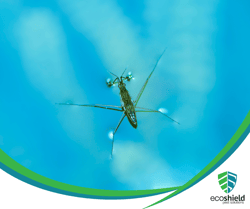While swimming pools are synonymous with fun, relaxation, and escaping the scorching summer heat, they also seem to have an irresistible allure for insects and other tiny critters. Whether you've found yourself fishing out unwelcome visitors from your pool or simply curious about why bugs gravitate towards these aquatic havens, join us as we explore the fascinating reasons behind this age-old conundrum… and what you can do about it!
Water and Bugs: What’s the Attraction?
If you’ve ever found yourself near a body of water, you’ll have undoubtedly noticed the presence of bugs. A great variety of bugs seem to be attracted to water sources such as puddles, ponds, lakes, and pools, but what is the allure of water to these bugs? And what kind of bugs specifically tend to be the most drawn to natural and manmade waterways?
- Mosquitoes: In the realm of bugs and water, it is impossible to ignore the incessant buzzing of mosquitoes. These tiny, bloodsucking insects are notorious for their affinity for stagnant water. Swimming pools, birdbaths, and even puddles provide ideal breeding grounds for mosquito larvae. Female mosquitoes lay their eggs in standing water, ensuring a bountiful source of nourishment for their offspring. Additionally, the warmth and stillness of pool water make it an attractive location for these pests. The carbon dioxide and body heat emitted by humans further enhance their interest, making swimmers prime targets for their insatiable thirst for blood.
- Water Striders: Among the bugs captivated by water's allure, water striders stand out with their remarkable ability to glide gracefully across the surface of ponds, lakes, and even swimming pools. These insects, also known as pond skaters or water bugs, possess elongated bodies and slender legs that distribute their weight perfectly, allowing them to utilize surface tension to stay afloat. They are drawn to bodies of water due to the abundance of food sources, such as small insects and larvae. With their keen sense of vibrations, water striders detect the subtlest movements on the water's surface, enabling them to swiftly locate their prey.
- Backswimmers: In the realm of water-loving bugs, backswimmers claim their place as skilled hunters. These fascinating insects, belonging to the Notonectidae family, navigate the aquatic world in an unusual manner - upside down. Propelled by their powerful oar-like legs, backswimmers skillfully move beneath the water's surface. Their presence is frequently observed in swimming pools and other freshwater bodies as they actively hunt for prey, including mosquito larvae. Backswimmers are also attracted to light sources, often mistaking the reflection on the water for natural light.
- Mud Daubers: Among the water-attracted insects, mud daubers showcase a distinct affinity for moist environments. These solitary wasps construct their nests using mud, hence their name. Mud daubers search for puddles or damp areas near water sources to gather mud, which they use to build their characteristic tube-like nests. Although they are not directly attracted to the water itself, their preference for moist areas makes them a frequent sight near bodies of water. Mud daubers are beneficial insects, as they prey on spiders and other small insects, making them valuable allies in natural pest control.
- Japanese Beetles: Japanese beetles, known for their metallic green bodies and copper-colored wings, are attracted to both water and foliage. These voracious pests are drawn to moist areas, including the vicinity of watering holes or damp plants. Japanese beetle larvae, known as grubs, thrive in soil with sufficient moisture content. When they emerge as adults, these beetles consume foliage, flowers, and fruit. Consequently, the presence of water in the form of irrigation or nearby bodies of water can intensify their attraction to specific locations.
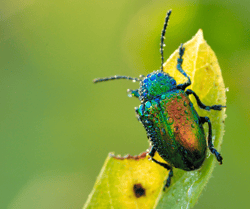 Japanese beetles are attracted to both water and foliage.
Japanese beetles are attracted to both water and foliage.
Do bugs like pools even if the water is chemically treated?
Chemically-treated pools are generally not the ideal source for water-loving bugs. That said, even though treatments in pools are often designed to deter bugs, some insects may still be attracted to the area despite these measures. Here are a few reasons why bugs may be drawn to chemically treated pools:
- Water Source: Even with chemical treatments, pools still provide a source of water, which is a fundamental necessity for many bugs. Insects are naturally drawn to water for drinking, hydration, and reproductive purposes. The presence of chemically treated water does not eliminate their basic need for moisture.
- Pheromones and Attraction Factors: Chemical treatments in pools may not affect the release of pheromones or other chemical signals that attract bugs. For instance, female mosquitoes release specific pheromones to attract males for mating. The chemical treatments in pools may not necessarily disrupt these natural reproductive signals.
- Adjacent Vegetation: Surrounding vegetation, such as trees, shrubs, or flowering plants, can still attract bugs to the pool area. The presence of flowers, nectar, or decaying organic matter can be appealing to insects, and they may venture towards the pool in search of these food sources.
- Chemical Resistance or Adaptation: Some bugs may have developed a level of resistance or adaptation to certain chemical treatments commonly used in pools. Over time, bugs can evolve to tolerate or avoid certain chemical compounds, allowing them to persist in the treated environment.
- Irrigation or Water Features: Pools equipped with irrigation systems or nearby water features, such as fountains or ponds, can still attract bugs. These additional water sources in close proximity to the pool may entice insects, as they provide alternative options for hydration and breeding.
It's important to note that while bugs may still be present around chemically treated pools, the treatments are intended to reduce their population and activity. Regular pool maintenance, including skimming, cleaning filters, and adjusting chemical levels, can help enhance the effectiveness of the treatments and minimize bug attraction.
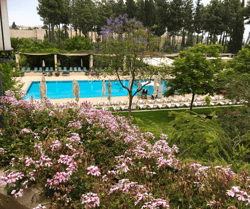 Surrounding vegetation, such as trees, shrubs, or flowering plants, can still attract bugs to the pool area.
Surrounding vegetation, such as trees, shrubs, or flowering plants, can still attract bugs to the pool area.
Can I Prevent Bugs in My Pool?
Yes! While preventing bugs entirely may not be possible, you can take several preventive measures to minimize the presence of bugs in your pool. Here are some effective ways to prevent bugs from infesting your pool:
- Regular Pool Maintenance: Maintaining proper pool hygiene is crucial in preventing bugs. Skim the pool surface regularly to remove leaves, debris, and other organic matter that can attract insects. Clean the pool filters and baskets to ensure optimal filtration and circulation, reducing the presence of bug-attracting substances.
- Use Pool Covers: Covering your pool when it's not in use can be an effective way to prevent bugs from entering the water. A properly fitted pool cover creates a barrier, keeping bugs and debris out and reducing their attraction to the pool.
- Proper Landscaping: Ensure that the landscaping around your pool is well-maintained. Trim back trees, shrubs, and plants to prevent them from overhanging or dropping leaves into the pool. Clear away any decaying vegetation or debris that could serve as a food source for bugs.
- Address Standing Water: Eliminate any sources of standing water near the pool area, such as empty containers, birdbaths, or puddles. Standing water provides an ideal breeding ground for mosquitoes and other water-loving insects. By removing these water sources, you can reduce the number of bugs attracted to your pool.
- Outdoor Lighting: Consider the placement and type of outdoor lighting near your pool. Bright white lights can attract insects at night. Instead, opt for yellow or sodium vapor lights, which are less appealing to bugs.
- Chemical Treatments: Use appropriate chemical treatments to maintain proper pool sanitation. Chlorine and other pool sanitizers help to deter bugs and inhibit their breeding. Follow the manufacturer's instructions for the correct application and dosage to ensure effective bug prevention without compromising the safety of swimmers.
- Consult a Professional: If you're facing persistent bug issues in your pool despite taking preventive measures, consider consulting a pest control professional like EcoShield. We can assess the situation, identify the specific bug species causing the problem, and provide targeted treatments or recommendations to address the issue effectively.
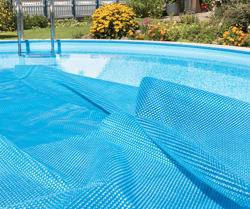 Covering your pool when it's not in use can be an effective way to prevent bugs from entering the water.
Covering your pool when it's not in use can be an effective way to prevent bugs from entering the water.
What Should I Do if my Pool is Infested With Bugs?
If your pool becomes infested with bugs, don’t worry! You don’t have to avoid your pool all summer long. There are several steps you can take to rid your pool of bugs and bring it back to optimal swimming status. Here is what we recommend doing when you have a pool overrun with unwanted insects:
- Identify the Bug Species: Take some time to observe and identify the specific bug species infesting your pool. Knowing the type of bug will help you determine the most effective course of action for removal and prevention.
- Skim and Vacuum: Start by skimming the surface of the water to remove any visible bugs, debris, or eggs. Use a pool net or skimmer to scoop them out. Next, use a pool vacuum to clean the pool thoroughly, paying attention to the bottom and sides where bugs may be hiding.
- Brush and Clean: Scrub the pool walls, steps, and any other surfaces with a pool brush to dislodge any remaining bugs or eggs. Follow up by cleaning the pool filters and baskets to ensure proper filtration and circulation.
- Shock the Pool: Shocking the pool with an appropriate pool shock treatment can help eliminate bugs and sanitize the water. Follow the manufacturer's instructions for dosage and application. This process will temporarily raise the chlorine levels in the water, effectively killing off bugs and bacteria.
- Maintain Proper Pool Chemistry: After shock treatment, maintain proper pool chemistry by regularly testing and adjusting the chlorine and pH levels. This will help deter future bug infestations and maintain a healthy swimming environment.
- Address Surrounding Factors: Assess the surroundings of your pool. Trim back vegetation, remove any decaying plant matter, and address any standing water sources nearby. By reducing the attractiveness of the area for bugs, you can help prevent them from returning to the pool.
- Consider Professional Assistance: If the infestation persists or is particularly severe, consider seeking help from a professional pest control service like EcoShield. We can assess the situation, identify the underlying cause, and provide targeted treatments to eliminate the bugs from your pool.
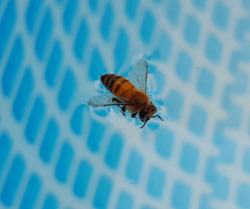
Remember to always follow safety precautions and instructions when applying chemicals yourself. Regular pool maintenance, proper sanitation, and diligent upkeep will help prevent future bug infestations and ensure a clean and enjoyable swimming experience. When in doubt, contact a trusted professional to ensure your pool remains bug-free safely.
If you’re concerned about bugs in your pool this summer, consider giving EcoShield a call for powerful prevention methods and expert advice. Give us a call or fill out the form on this page today!
